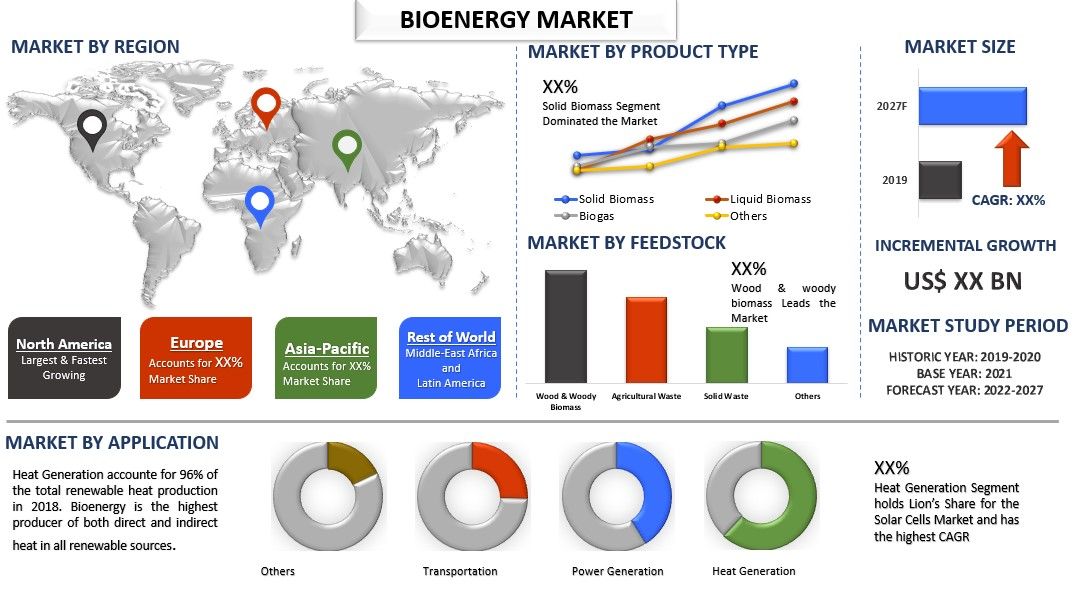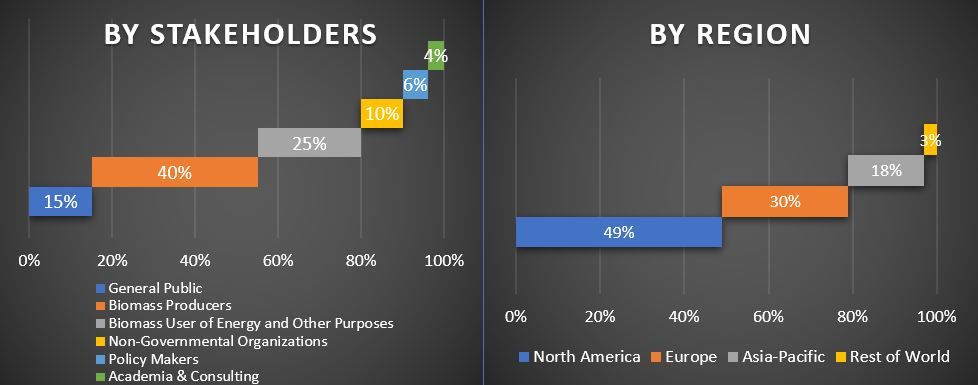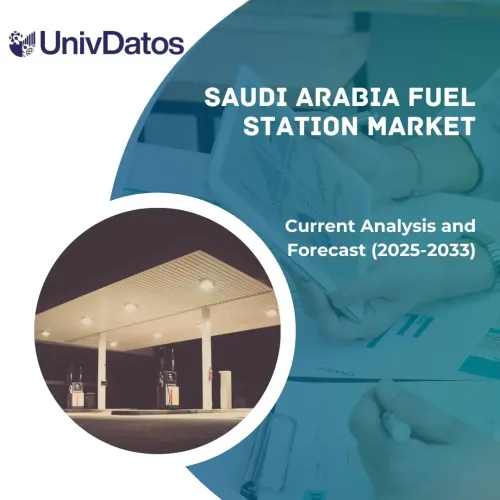Рынок биоэнергетики: текущий анализ и прогноз (2021-2027 гг.)
Акцент на типе продукта (твердая биомасса, жидкое биотопливо, биогаз, другое); Сырье (сельскохозяйственные отходы, древесина и древесная биомасса, твердые отходы, другое); Применение (производство электроэнергии, производство тепла, транспорт, другое); Регион и страна

Ожидается, что к 2027 году объем рынка биоэнергетики превысит 600 миллиардов долларов США, а среднегодовой темп роста составит более 8% в течение прогнозируемого периода (2021-2027 гг.). Биоэнергия - это возобновляемый источник энергии, получаемый из органических материалов, известных как биомасса. Она может использоваться для производства энергии для отопления, электроэнергии, транспорта и продукции. Энергия, получаемая из биомассы, известна как биоэнергия. Биомасса, используемая в качестве источника энергии, называется сырьем и может варьироваться от растений и древесины до пищевых и сельскохозяйственных отходов и даже сточных вод. Сухое горючее сырье, такое как древесные гранулы, сжигается в печах или котлах, которые кипятят воду, создающую пар и приводящую в действие турбину для производства электроэнергии. При сжигании биомассы выделяется углекислый газ. Однако чистый выброс углерода сбалансирован, поскольку выделяется то же количество углекислого газа, которое было поглощено при выращивании органического вещества. Таким образом, углеродный цикл сбалансирован. В то время как ископаемое топливо высвобождает углекислый газ, который был заперт в течение миллионов лет, что нарушает текущий углеродный баланс Земли. Устойчивость биоэнергии лучше всего анализировать, различая, используются ли отходное сырье или энергетические культуры.
ЗАПРОСИТЬ БЕСПЛАТНЫЙ ОБРАЗЕЦ PDF
Ключевые факторы, влияющие на рост рынка биомассы, включают в себя ее широкую доступность в качестве возобновляемого источника энергии, поскольку органические материалы, используемые для производства биомассы, легко доступны, в то время как в случае других возобновляемых источников трудно полагаться на их постоянную доступность. Биомасса производится из органических материалов/отходов, которые обычно гниют и производят CO2 и даже метан (парниковый газ, в 21 раз более сильный, чем CO2). Следовательно, биоэнергия не только устойчива, но и снижает CO2, который в любом случае был бы произведен. Кроме того, производители получают дополнительный доход, производя биоэнергию из своих оставшихся отходов. Это также сокращает количество мусора, сбрасываемого на свалки, на 60-90% и снижает стоимость утилизации на свалках. Более того, ожидается, что население мира увеличится до 8 или даже до 10,5 миллиардов к 2050 году, что увеличит потребность в потреблении энергии, и для удовлетворения этого растущего спроса необходимо более эффективно использовать природные ресурсы и, таким образом, необходим переход на биотопливо.
Общий объем первичной энергии из возобновляемых источников в мире (EJ), 2000-2018 гг.
Enexor Energy, Lignetics, Green Plains Inc., Enviva, Enerkem, POET, Drax Group, Pacific BioEnergy Corp, EnviTec Biogas AG и MVV Energie AG являются одними из известных игроков, работающих на рынке биоэнергетики. Эти игроки предприняли несколько слияний и поглощений, а также партнерств, чтобы предоставлять клиентам высокотехнологичные и инновационные продукты/технологии.
Аналитические выводы, представленные в отчете
"Среди типов продукции наибольшую долю занимает сегмент твердой биомассы"
На основе типа продукции рынок сегментирован на твердую биомассу, жидкое биотопливо, биогаз и другие. Среди типов продукции сегмент твердой биомассы на рынке биоэнергетики оценивался в XX миллиардов долларов США в 2020 году и, вероятно, достигнет XX миллиардов долларов США к 2027 году, увеличиваясь в среднем на XX% с 2021 по 2027 год. Биомасса - это возобновляемый органический материал, производимый из растений и животных. До середины 1800-х годов биомасса была крупнейшим источником общего годового потребления энергии в Соединенных Штатах. Использование биомассы вместо ископаемого топлива позволило избежать выбросов CO2 во многих странах. В 2020 году 5 квадриллионов британских тепловых единиц (Btu) и около 5% от общего объема энергии было обеспечено с использованием биомассы в Соединенных Штатах.
"Среди сырья наибольшую долю занимает сегмент древесины и древесной биомассы"
На основе сырья рынок биоэнергетики сегментирован на сельскохозяйственные отходы, древесину и древесную биомассу, твердые отходы и другие. Среди сырья на долю сегмента древесины и древесной биомассы приходилась рыночная оценка в размере XX миллиардов долларов США в 2020 году и, как ожидается, она достигнет XX миллиардов долларов США к 2027 году, при среднегодовом темпе роста XX% за анализируемый период. Древесная биомасса состоит из деревьев, коры, стволов, ветвей и т. д. Они имеют высокое содержание лигнина, который производит большое количество тепла и также используется в производстве электроэнергии. В 2018 году 2% от общего потребления энергии в Соединенных Штатах приходилось на древесину и отходы древесной биомассы. Энергию из древесины можно получить, непосредственно сжигая древесину, или можно сжигать древесину в смеси древесины, угля и других источников топлива. Косвенные методы включают получение энергии путем термической или химической конверсии.
"Среди применений наибольшую долю занимает сегмент теплогенерации"
На основе применения рынок биоэнергетики сегментирован на производство электроэнергии, теплогенерацию, транспорт и другие. Сегмент теплогенерации принес доход в размере XX миллиардов долларов США в 2020 году и, как ожидается, будет расти в среднем на XX% в течение прогнозируемого периода, достигнув рыночной оценки в размере XX миллиардов долларов США к 2027 году. Биотопливо имеет высокое теплосодержание и чаще всего используется для производства тепла, что делает его самым быстрорастущим сегментом. Ожидается, что в Европе использование биоэнергии для отопления вырастет на 8% к 2023 году, достигнув 3,5 эксаджоулей (EJ). Европейский союз использовал более 15 миллионов тонн древесных гранул для отопления в 2018 году. Возобновляемая биомасса преобразуется в тепло посредством 3 процессов: бактериального разложения, сжигания и преобразования в жидкое или газообразное топливо.
"Северная Америка представляет собой один из крупнейших рынков биоэнергетики"
Для лучшего понимания динамики рынка биоэнергетики был проведен подробный анализ для различных регионов по всему миру, включая Северную Америку (США, Канаду и остальную часть Северной Америки), Европу (Германию, Францию, Италию, Великобританию, Испанию и остальную часть Европы), Азиатско-Тихоокеанский регион (Китай, Японию, Индию, Австралию и остальную часть Азиатско-Тихоокеанского региона) и остальной мир. США доминировали на рынке и захватили около XX% доли рынка благодаря растущей осведомленности о возобновляемых источниках энергии в регионе.
Причины купить этот отчет:
- Исследование включает в себя анализ размера рынка и прогнозирования, подтвержденный аутентифицированными ключевыми экспертами отрасли
- Отчет представляет собой краткий обзор общей производительности отрасли с первого взгляда
- Отчет охватывает углубленный анализ видных коллег по отрасли с основным упором на ключевые финансовые показатели бизнеса, портфель продуктов, стратегии расширения и последние разработки
- Подробное изучение движущих сил, ограничений, ключевых тенденций и возможностей, преобладающих в отрасли
- Исследование всесторонне охватывает рынок по различным сегментам
- Углубленный анализ отрасли на региональном уровне
Варианты настройки:
Рынок биоэнергетики может быть дополнительно настроен в соответствии с требованиями или любым другим сегментом рынка. Кроме того, UMI понимает, что у вас могут быть свои собственные потребности в бизнесе, поэтому не стесняйтесь связаться с нами, чтобы получить отчет, который полностью соответствует вашим требованиям.
Содержание
Анализ исторического рынка, оценка текущего рынка и прогнозирование будущего рынка биоэнергетики были тремя основными этапами, предпринятыми для создания и анализа внедрения биоэнергетики в основных регионах мира. Было проведено исчерпывающее вторичное исследование для сбора исторических данных о рынке и оценки текущего размера рынка. Во-вторых, для подтверждения этих выводов было принято во внимание множество результатов и предположений. Кроме того, были проведены исчерпывающие первичные интервью с отраслевыми экспертами по всей цепочке создания стоимости рынка биоэнергетики. После предположения и проверки рыночных показателей посредством первичных интервью мы использовали подход "сверху вниз/снизу вверх" для прогнозирования полного размера рынка. После этого были приняты методы разбивки рынка и триангуляции данных для оценки и анализа размера рынка сегментов и подсегментов, к которым относится отрасль. Подробная методология описана ниже:
Анализ исторического размера рынка
Шаг 1: Углубленное изучение вторичных источников:
Было проведено подробное вторичное исследование для получения исторических данных о размере рынка биоэнергетики из внутренних источников компаний, таких как годовые отчеты и финансовая отчетность, презентации о результатах деятельности, пресс-релизы и т. д., и внешних источников, включая журналы, новости и статьи, правительственные публикации, публикации конкурентов, отраслевые отчеты, сторонние базы данных и другие надежные публикации.
Шаг 2: Сегментация рынка:
После получения исторических данных о размере рынка биоэнергетики мы провели подробный вторичный анализ для сбора исторических данных о рынке и доли различных сегментов и подсегментов для основных регионов. Основные сегменты, включенные в отчет, включают тип продукта, сырье и применение. Был проведен дальнейший анализ на уровне стран для оценки общего внедрения биоэнергетики в этом регионе.
Шаг 3: Факторный анализ:
После получения исторических данных о размере рынка различных сегментов и подсегментов мы провели подробный факторный анализ для оценки текущего размера рынка биоэнергетики. Кроме того, мы провели факторный анализ с использованием зависимых и независимых переменных, таких как повышение осведомленности о возобновляемых источниках и сокращение потерь за счет использования биоэнергетики. Был проведен тщательный анализ сценариев спроса и предложения с учетом ведущих партнерств, слияний и поглощений, расширения бизнеса и запуска продуктов в секторе биоэнергетики по всему миру.
Оценка и прогноз текущего размера рынка
Определение текущего размера рынка: На основе практически применимых данных, полученных на основе вышеуказанных 3 шагов, мы определили текущий размер рынка, ключевых игроков на рынке биоэнергетики и доли рынка сегментов. Все необходимые процентные доли и разбивки рынка были определены с использованием вышеупомянутого вторичного подхода и проверены посредством первичных интервью.
Оценка и прогнозирование: Для оценки и прогнозирования рынка различным факторам, включая драйверы и тенденции, ограничения и возможности, доступные для заинтересованных сторон, были присвоены веса. После анализа этих факторов были применены соответствующие методы прогнозирования, т. е. подход "сверху вниз/снизу вверх", для получения прогноза рынка примерно до 2027 года для различных сегментов и подсегментов на основных рынках по всему миру. Методология исследования, принятая для оценки размера рынка, включает:
- Размер рынка отрасли в стоимостном выражении (доллары США) и темпы внедрения биоэнергетики на основных рынках внутри страны
- Все процентные доли, разбивки и распределения сегментов и подсегментов рынка
- Ключевые игроки на рынке биоэнергетики с точки зрения предлагаемых продуктов. Кроме того, стратегии роста, принятые этими игроками для конкуренции на быстрорастущем рынке
Проверка размера рынка и доли рынка
Первичное исследование: Были проведены углубленные интервью с ключевыми лидерами мнений (KOL), включая руководителей высшего звена (CXO/вице-президенты, руководители отдела продаж, руководители отдела маркетинга, руководители операционного отдела и региональные руководители, руководители стран и т. д.) в основных регионах. Затем были обобщены результаты первичных исследований и проведен статистический анализ для доказательства заявленной гипотезы. Данные первичных исследований были объединены с результатами вторичных исследований, что позволило превратить информацию в практически применимые данные.
Разбивка первичных участников по различным регионам
Инжиниринг рынка
Для завершения общей оценки рынка и получения точных статистических данных по каждому сегменту и подсегменту рынка биоэнергетики была применена техника триангуляции данных. Данные были разбиты на несколько сегментов и подсегментов после изучения различных параметров и тенденций в областях типов и их типов на рынке биоэнергетики.
Основная цель исследования рынка биоэнергетики
В исследовании были точно определены текущие и будущие рыночные тенденции биоэнергетики. Инвесторы могут получить стратегические сведения для обоснования своих решений об инвестициях на основе качественного и количественного анализа, проведенного в исследовании. Текущие и будущие рыночные тенденции определили общую привлекательность рынка на региональном уровне, предоставив промышленному участнику платформу для освоения неиспользованного рынка, чтобы извлечь выгоду в качестве преимущества первопроходца. Другие количественные цели исследований включают:
- Проанализировать текущий и прогнозируемый размер рынка биоэнергетики в стоимостном выражении (доллары США). Кроме того, проанализировать текущий и прогнозируемый размер рынка различных сегментов и подсегментов
- Сегменты в исследовании включают области типов и их подтипов
- Определение и анализ нормативно-правовой базы для индустрии биоэнергетики
- Проанализировать цепочку создания стоимости с участием различных посредников, а также проанализировать поведение клиентов и конкурентов в отрасли
- Проанализировать текущий и прогнозируемый размер рынка биоэнергетики для основного региона
- Основные регионы, изученные в отчете, включают Северную Америку (США, Канада и остальная часть Северной Америки), Европу (Германия, Великобритания, Франция, Испания, Италия и остальная часть Европы), Азиатско-Тихоокеанский регион (Китай, Япония, Индия, Австралия и другие) и остальной мир
- Профили компаний рынка биоэнергетики и стратегии роста, принятые участниками рынка для поддержания устойчивости на быстрорастущем рынке
- Углубленный анализ отрасли на региональном уровне
Связанные Отчеты
Клиенты, купившие этот товар, также купили












